|
(11) | EP 3 310 778 B1 |
| (12) | EUROPEAN PATENT SPECIFICATION |
|
|
| (54) |
KOJIC ACID-DERIVED MANNICH BASES WITH BIOLOGICAL EFFECT MANNICHBASEN AUS KOJISÄURE MIT BIOLOGISCHER WIRKUNG BASES DE MANNICH DÉRIVÉES DE L'ACIDE KOJIQUE AYANT UN EFFET BIOLOGIQUE |
|
|
|||||||||||||||||||||||||||||||
| Note: Within nine months from the publication of the mention of the grant of the European patent, any person may give notice to the European Patent Office of opposition to the European patent granted. Notice of opposition shall be filed in a written reasoned statement. It shall not be deemed to have been filed until the opposition fee has been paid. (Art. 99(1) European Patent Convention). |
Field of the Invention
[0001] The present invention relates to the following kojic acid-derived mannich base compounds with biological effect, and hydrates, solvates, pharmacologically acceptable salts or geometric isomers thereof,
wherein R1 is selected as
Background Art
[0002] Nowadays, tyrosinase inhibitors are gradually gaining importance in medicine, cosmetics and food industries. Several natural or synthetic tyrosinase inhibitors have been discovered. However, a few of them can be used as skin bleaching agents due to the toxicity problems. The most important skin bleaching agents are hydroquinone, hydroquinone manomethyl ether, arbutin, kojic acid and azelaic acid. Use of hydroquinone in skin bleacher cosmetics is prohibited because of its clinical side effects, and use of less toxic derivatives thereof is preferred. Only a few antimelanogenic agents such as kojic acid and arbutin are commercially available in the market.
[0003] Kojic acid has antibacterial and antifungal properties, which inhibits catecholase activity of tyrosinase that is an essential rate-limiting enzyme in biosynthesis of melanin pigment which gives skin its color. Therefore, it is contained in dermocosmetics / cosmeceutics for depigmentation after sunburn and in the treatment of hyperpigmentation in the cosmetic industry in order to prevent enzymatic darkening, for its skin bleaching effect. The presence of kojic acid in cosmetic products inhibits tyrosinase enzyme by preventing reuptake of oxygen required for slow and reversible competitive darkening, and it is also known that it forms chelation with active site copper metals, which is effective on the enzyme activity. Iron released in the skin due to chronic exposure to the sun rays causes wrinkles. The experiments of kojic acid on hairless rats showed that wrinkles observed on the kojic acid administered rats subjected to UV rays are less than those seen on the skin of the rats not received kojic acid. Furthermore, it is also used in the food and cosmetic industry in order to increase shelf life, due to its protective effect against physical and chemical degradation. In order to prevent spot formation resulting from storage and processing of colored food products, kojic acid also finds application as an anti-spot due to its tyrosinase inhibitory feature.
[0004] In recent years, in order to improve the low stability of kojic acid, ester, tripeptide-amides and aminoacid-amides are synthesized, and an examination made on the antityrosinase activity thereof revealed that their stability is increased to a great extent. This result is based on an increase in hydrophobic interactions between the synthesized compounds and tyrosinase active site. In the subsequent studies, metal complexes of these derivatives with strong antityrosinase effect are prepared in order to solve the problem of low cellular permeability. In another study, tyrosinase inhibitory activity is examined, wherein kojic acid derivatives are obtained by joining pyrone cores of two kojic acid molecules through an ethylene linkage, which are 8 times more active than kojic acid. In kojyl thioether derivatives, tyrosinase inhibitory activity is also increased by appropriate lipophilic alkyl chains, and in ester derivatives, compounds are synthesized which are more effective than the kojic acid. Moreover, complexes of kojic acid derivatives in the form of mannic base with ruthenium metal are prepared, to obtain anticancer activity. Currently, use of kojic acid in pharmaceutical products is not approved by the FDA. In a research on current use concentrations conducted by Personal Care Products Council, it is observed that kojic acid is used at a concentration of 0.1-2%, with the highest concentration being used in face and neck creams, lotions and powders.
[0005] An article titled "Synthesis and Evaluation of Anticonvulsant and Antimicrobial Activities of 3-Hydroxy-6- methyl-2-substituted 4H-Pyran-4-one Derivatives" discloses the compounds synthesized from kojic acid, and having the chemical formula given below. Herein, it is determined that a compound, wherein R is a benzyl, does not exhibit anticonvulsant and antifungal activity.
[0006] In another study, 3-hydroxy-6-hydroxymethyl-2-substituted 4H-pyran-4-one derivatives are synthesized and their anticonvulsant activity is examined.
[0007] Since kojic acid exhibits high toxicity against cells and low stability against water and oxygen, it has a limited application area. Furthermore, kojic acid and some derivatives thereof are low soluble in oil and unstable at high temperature for long-term storage. This directly prevents use of those substances in oil-containing cosmetic and skin care products. For kojic acid used as a skin bleacher, skin lightener and depigmentation agent in cosmetic products, ester derivatives such as kojic dipalmitate and kojic isopalmitate are present in the marketed products as a cosmetic ingredient. Therefore, it has become important to obtain more reliable new derivatives of kojic acid, in order to improve physical properties and biological activities thereof and enhance its industrial application area. Moreover, kojic acid that is allowed to be used at only low doses due to its toxic effects on thyroid gland has low permeability and stability problems. Therefore, more efficacious and safe products should be developed.
[0008] Due to their damage on both medical and leather and textile sectors, dermatophytes are fungi that cause great economical damages. Today, there is a need for new antifungal agents since antifungal drugs are used in the treatment of dermatophytes that settle on skin, hair and nails where they cause common infections, and fungi rapidly develop resistance to existing drugs.
[0009] Mycobacterium avium subsp. paratuberculosis is a pathogen which causes paratuberculosis in milk cows, i.e. Johne disease, and which is also linked to Crohn disease in humans. It is abundant in nature, soil and water. It is also commonly available in household dust and plants. Mycobacterium avium complex (MAC) is the cause of pulmonary diseases in AIDS patients. It is a disease cause in animals and humans. It is a factor responsible for contamination of water. It is spread by ingestion of contaminated water and foods. New treatment methods have been developed by preparing combinations of commercially available antibiotics, but new antibiotics could not be developed which have antimycobacterial effect.
Brief Description of the Invention
[0010] The present invention relates to the following kojic acid-derived mannich base compounds with biological effect, and geometric isomers or pharmacologically acceptable salts thereof,
wherein R1 is
[0011] The inventive compounds have antidermatophytic, antimycobacterial, antityrosinase, anti-aging and antioxidant effects.
Object of the Invention
[0012] An object of the present invention is to synthesize new kojic acid-derived compounds, which have a better permeability than kojic acid and are not irritative, in high amounts and without by-product formation by means of a simple method that is conducted at room temperature and is efficient.
[0013] Another object of the present invention is to synthesize compounds that exhibit better antityrosinase, antioxidant, anti-aging, antidermatophytic and antimycobacterial effect than other kojic acid and derivative compounds.
Description of the Invention
[0014] The invention consists of two new bioactive compounds in the form of a mannich base synthesized from kojic acid. Physical properties of the compounds such as efficiency of synthesis reactions and melting points are determined. The structure of the compounds are demonstrated by spectroscopic methods such as IR, 1H-NMR, 13C-NMR and ESI-MS, and proved by elemental analysis results. Antidermatophytic activity of the compounds against Trichophyton mentagrophytes var. erinacei, Epidermophyton floccosum and Microsporum gypseum as well as their antimycobacterial activity against Mycobacterium tuberculosis H37Rv (ATCC 27294) and M. avium (ATCC 15769) are analyzed under non-toxic concentrations using MRC-5 and He-La cell lines. Antityrosinase activity thereof is determined by spectrophotometric method using L-DOPA as a substrate. Antioxidant activity is determined by the methods of 2,2-diphenyl-1-picrilhydrasil (DPPH), N,N-dimethyl-p-phenylenediamine (DMPD) radical scavenging activity, metal chelation effect, iron-(FRAP), phosphomolybdenum-(PRAP) reducing antioxidant power. Elastase and collagenase enzyme inhibitions are performed to determine anti-aging activity. Due to their antityrosinase, antioxidant, anti-aging, antidermatophytic and antimycobacterial effects, the compounds may be used in medicine, cosmeceutical, food and textile industry.
[0015] In order to obtain compounds having a higher antityrosinase activity than kojic acid, the compounds of Formula 1 and 2 of the present invention have been synthesized which have a similar structure to kojic acid but is more lipophilic and alkaline through a benzylpiperazine group added to the structure with mannich base.
[0016] By increasing oil solubility of the obtained compounds, low permeability problem of the kojic acid is eliminated. Synthesis is performed with a simple method which is conducted at room temperature and is efficient. No by-products are generated. This method is advantageous in synthesis of a high amount of substance, with its high productivity and simplicity.
Synthesis of 3-Hydroxy-6-hydroxymethyl-2-substituted-4H-pyran-4-one derivatives
[0017] Formaldehyde is added to substituted benzylpiperazine derivative (1 mol) and is mixed. Kojic acid (1 mol) is added to the solution. An amount of methanol sufficient to dissolve kojic acid is added to the medium and shaken at room temperature. Precipitated solid is filtered under vacuum and rinsed with cold methanol.
Kojic Acid KA
R:Subsstituted benzylpiperazine derivative
3-Hydroxy-6-(hydroxymethyl)-2-[[4-(3,4-diclorobenzyl)piperazine-1-il]methyl]-4H-pyran-4-one presented in Formula 1 and synthesis
[0018] Kojic acid is obtained from 1-(3,4-diclorobenzyl)piperazine and formaldehyde using general synthesis method. Melting point: 180-1 °C, Yield: 90%. White powder crystals. Insoluble in water, low-solubility in methanol, ethanol and acetone, and soluble in chloroform.
[0019] IR spectrum; peaks at 1607 (C=O, stretching), 1455 (C=C, stretching), 1196 cm-1 (C-O, stretching). 1H-NMR spectrum; peaks at δ (DMSO-d6, 400 MHz) 2.37 (4H; brs; piperazine), 2.47 (4H; brs; piperazine), 3.45 (2H; s; -CH2-), 3.51 (2H; s; -CH2-phenyl), 4.28 (2H; s;-CH2OH), 5.61 (1H; brs; -CH2OH); 6.31 (1H; s; H5), 7.28 (1H; dd; J= 8; J= 2; Ar-H6'), 7.51 (1H; d; J= 2; Ar-H2'), 7.56 (1H; d; J= 8; Ar-H5') 8.89-8.98 (1H; br; -OH). 13C-NMR spectrum; peaks at δ (DMSO, 400 MHz) 52.27 (-CH2), 52.32 (-CH2), 53.46 (-CH2), 59.51 (-CH2), 60.24 (-CH2), 108.85 (-CH), 128.84 (-CH), 129.24 (-CH), 130.24 (-CH), 130.33 (-Cphenyl), 130.74 (-Cphenyl), 139.56 (-Cphenyl), 143.59 (-Cpyrone), 146.41 (-Cpyrone),167.49 (-Cpyrone), 173.49 (-Cpyrone). On mass spectrum (ESI-MS) m/z; peaks are seen at 399 (100%, M+), 401 (M++2), 421 (M++Na).
| Analysis | : | C18H20Cl2N2O4 (M.A.: 399.27 g/mol) | ||
| C% | H% | N% | ||
| Calculated | : | 54.15 | 5.05 | 7.02 |
| Found | : | 54.01 | 5.10 | 7.27 |
3-Hydroxy-6-(hydroxymethyl)-2-[[4-(2,6-diclorobenzyl)piperazine-1-il]methyl]-4H-pyran-4-one presented in Formula 2 and synthesis
[0020] Kojic acid is obtained from 1-(2,6-diclorobenzyl)piperazine and formaldehyde using general synthesis method. Melting point 196-7°C, Yield: 93%. White powder crystals. Insoluble in water, methanol, ethanol and acetone, but soluble in chloroform.
[0021] IR spectrum; peaks at 1607 (C=O, stretching), 1435 (C=C, stretching), 1,197 cm-1 (C-O, stretching). 1H-NMR spectrum; peaks at δ (DMSO-d6, 400 MHz) 2.41 (4H; brs; piperazine), 2.49 (4H; brs; piperazine), 3.50 (2H; s; -CH2-), 3.66 (2H; s; -CH2-fenil), 4.28 (2H; s; - CH2OH), 5.60 (1H; brs; -CH2OH); 6.30 (1H; s; H5), 7.31 (1H; t; J= 8; J= 2; Ar-H4'), 7.44 (2H; d; J= 8; Ar-H3', H5'), 8.89-8.98 (1H; br; -OH). 13C-NMR spectrum; peaks at δ (DMSO, 400 MHz) 52.28 (-CH2), 52.41 (-CH2), 53.43 (-CH2), 55.79 (-CH2), 59.49 (-CH2), 108.84 (-CH), 128.48 (-CH), 129.73 (-CH), 133.54 (-Cphenyl), 135.99 (-Cphenyl), 143.58 (-Cpyrone), 146.36 (-Cpyrone), 167.48 (-Cpyrone), 173.46 (-Cpyrone). On mass spectrum (ESI-MS) m/z; peaks are seen at 399 (100%, M+), 401 (M++2), 421 (M++Na).
| Analysis | : | C18H20Cl2N2O4 (M.A.: 399.27 g/mol) | ||
| C% | H% | N% | ||
| Calculated | : | 54.15 | 5.05 | 7.02 |
| Found | : | 54.04 | 4.87 | 7.35 |
[0022] In order to determine the activity of the compounds according to the present invention, the claimed compounds are compared with kojic acid and different kojic acid derivatives and tested.
[0023] It is found that the compound of Formula 1 has a greater tyrosinase inhibitory effect at low doses than kojic acid (Table 1).
Table 1. Low-dose antityrosinase activity results
| 0.0025 mg/ml | 0.005 mg/ml | 0.01 mg/ml | 0.025 mg/ml | 0.05 mg/ml | 0.1 mg/ml | 0.25 mg/ml | |
| Compound of Formula 1 | 23.63±1.65 | 37.81±0.54 | 51.25±1.09 | 56.79±0.44 | 70.62±1.62 | 73.57±4.81 | 80.63±2.01 |
| Kojic Acid | 18.65±1.33 | 44.74±0.53 | 61.28±2.03 | 77.44±0.68 |
[0024] Tyrosinase inhibitory activity results of a group of kojic acid-derived compounds, a compound of Formula 1 and a compound of Formula 2 of the present invention and kojic acid are analyzed (Tables 1 and 2). The values of the compound of Formula 1 and kojic acid IC50 (mg/ml) are 0.011±0.001 mg/ml and 0.067±0.001 mg/ml, respectively. It is determined that the compound of Formula 1 has a 6 times higher antityrosinase effect than kojic acid. It is also determined that the compound of Formula 2 exhibits medium inhibition (43.74±2.72 mg/ml) at the highest dose (5 mg/ml).
Table 2. Antityrosine activity results
|
|
Tyrosinase Enzyme Inhibition (Inhibition%±S.S) | |||||
| -R1 | -R2 | 0.5 mg/ml | 1 mg/ml | 2.5 mg/ml | 5 mg/ml | IC50 (mg/ml) |
| -CH3 |
|
28.33±1.83 | 27.69±0.92 | 25.66±2.44 | - | |
| -CH2Cl |
|
14.27±1.80 | 18.88±1.61 | 19.00±3.40 | 22.60±3.88 | |
| -CH2OH |
|
10.37±0.68 | 24.71±2.31 | 22.40±0.14 | 14.52±0.41 | |
| -CH2OH |
|
25.40±0.89 | 28.64±0.13 | - | - | |
| -CH2OH |
|
30.19±0.54 | 35.10±0.41 | 49.33±0.14 | 56.44±0.68 | <.5 |
| Compound of Formula 1 | 83.94±0.29 | 82.78±1.64 | 84.38±1.16 | 89.59±0.50 | 0.011+0.001 | |
| -CH2OH |
|
|||||
| Compound of Formula 2 | 16.28±0.14 | 18.50±0.82 | 13.36±0.81 | 43.74±2.72 | ||
| -CH2OH |
|
|||||
| Kojic Acid | 84.34±0.47 | 88.35±0.33 | 90.98±0.19 | 91.92±0.01 | 0.067±0.001 | |
[0025] It is scientifically reported that the most common dermatophyte fungus strain in our country is Trichophyton. It is found that the compound of Formula 1 (MIC 1-2 µg ml-1) has a greater dermatophytic effect against Trichophyton mentagrophytes var. erinocei and Epidermophyton floccosum than kojic acid (MIC 4 µg ml-1). Against the three dermatophyte strains, the compound of Formula 2, at MIC 1 µg ml-1, has a greater antidermotophytic activity than kojic acid (MIC 2-4 µg ml-1) and the compound of Formula 1.
[0026] Table 3 shows antidermatophytic and antimycobacterial activity results and cytotoxicity data [in µg ml-1, MIC (Minimum Inhibition Concentration) and MNTC (Maximum Non-Toxic Concentration) values] of a group of kojic acid-derived compounds, certain compounds already used in the art, kojic acid and the compound of Formula 1 and the compound of Formula 2. Of all the compounds given above, the claimed compounds of Formula 1 and Formula 2 have the strongest effect.
Table 3. Antidermatophytic and antimycobacterial activity results
|
|
Microorganisms | ||||||||
| Trichophyton mentagrophytes var. erinacei | Epidermophyton floccosum | Microsporum gypseum | Mycobacteria | ||||||
| -R1 | -R2 | NCPF375 | Isolated strains | RSKK 3027 | Isolated strains | NCPF 580 | Isolated strains | M. tuberculosis ATCC27294 | M. avium ATCC15769 |
| MIC | MIC | MIC | MIC | ||||||
| -CH3 |
|
4 | 16 | 16 | 32 | 16 | 32 | 64 | 16 |
| -CH2Cl |
|
4 | 8 | 4 | 8 | 4 | 8 | 16 | 8 |
| -CH2Cl |
|
4 | 8 | 4 | 8 | 4 | 8 | 16 | 8 |
| -CH2OH |
|
4 | 8 | 8 | 8 | 4 | 8 | 32 | 16 |
| -CH2OH |
|
4 | 8 | 4 | 8 | 4 | 8 | 32 | 16 |
| -CH2OH |
|
2 | 4 | 2 | 4 | 2 | 4 | 16 | 16 |
| Compound of Formula 1 | 1 | 2 | 2 | 2 | 2 | 2 | 16 | 2 | |
| -CH2OH |
|
||||||||
| Compound of Formula 2 | 1 | 2 | 1 | 2 | 1 | 2 | 32 | 2 | |
| -CH2OH |
|
||||||||
| Kojic Acid | 4 | 4 | 4 | 4 | 2 | 2 | 32 | 16 | |
| Terbinafine | 0.125 | 0.25 | 0.25 | 0.5 | 0.25 | 0.5 | - | - | |
| Griseofulvin | 0.5 | 1 | 0.5 | 1 | 0.5 | 1 | - | - | |
| Itraconazole | 0.25 | 0.5 | 0.12 5 | 0.25 | 0.12 5 | 0.25 | - | - | |
| Isoniazide | - | - | - | - | - | - | 0.125 | 0.125 | |
| Ethambutol | - | - | - | - | - | - | 2 | 2 | |
| Streptomycin | - | - | - | - | - | - | 1 | 2 | |
[0027] As an antimycobacterial, both compounds have a high activity against M. avium at MIC 2 µg ml-1 as compared to kojic acid (MIC 16 µg ml-1). It is as effective as the reference drug ethambutol and streptomycin (MIC 2 µg ml-1) which are still used and available in Turkey (Table 3). A gradual increase in the number of pathogen bacteria and fungus resistant to general therapeutic agents is a current problem around the world. It has become highly important to develop new antibiotics.
[0028] Antioxidant activity of the compound of Formula 1, the compound of Formula 2 and kojic acid is determined by the methods of 2,2-diphenyl-1-picrilhydrasil (DPPH), N,N-dimethyl-p-phenylenediamine (DMPD) radical scavenging activity, metal chelation effect, iron-(FRAP), phosphomolybdenum-(PRAP) reducing antioxidant power. An examination of the results of these methods revealed that the compound in Formula 1 (67.57±1.30 µg/ml) and the compound in Formula 2 (58.17±0.99 µg/ml) at a dose amount of 1000 µg/ml has a mild iron chelation effect higher than kojic acid (8.89±0.75 µg/ml) but lower than the reference compound ethylenediaminetetraacetic acid (EDTA, 97.66±0.12-2000 µg/ml). Since iron ion and other transition metal ions catalyze oxidation in the body, it is important to examine metal chelation effect of an antioxidant. A comparison of antioxidant power of phosphomolybdenum structure and antioxidant effects demonstrates that the compound of Formula 2 (0.187±0.017 µg/ml) and the compound of Formula 1 (0.154±0.004 µg/ml), though lower than the reference compound flavonoid quercetin of vegetable origin (0.320±0.005 µg/ml), shows a higher antioxidant effect than kojic acid (0.103±0.006 µg/ml) (Table 4).
Table 4: Antioxidant and anti-aging activity results
| DPPH Free Radical Scavenging Effect (Scavenging %±S.S) 1000 µg/ml | Metal Chelation Effect (Chelation% ±S.S) 1000 µg/ml | Iron Reduction Antioxidant Power (Absorbance at 700 nm±S.S) 1000 µg/ml | Phosphomolybdenum Reduction Antioxidant Power (Absorbance at 600 nm±S.S) 1000 µg/ml | DMPD Radical Scavenging Effect (Scavenging% ±S.S) 1000 µg/ml | Collagenase Enzyme Inhibition (Inhibition% ±S.S) 1000 µg/ml-Stock | |
| Compound of Formula 1 | 14.59±2.52 | 67.57±1.30 | 0.274±0.003 | 0.154±0.004 | 36.05±3.11 | 15.57±2.24 |
| Compound of Formula 2 | 12.20±1.72 | 58.17±0.99 | 0.217±0.002 | 0.187±0.017 | 24.94±1.64 | 12.40±4.57 |
| Kojic Acid | 22.51±2.65 | 8.89±0.75 | 0.757±0.026 | 0.103±0.006 | 41.86±1.10 | 15.18±5.92 |
| Quercetin | 91.14±0.65 | - | 2.015±0.032 | 0.320±0.005 | - | |
| EDTA-2000 µg/ml | - | 97.66±0.12 | - | - | - | |
| Ascorbic acid | - | - | - | - | 69.58±0.71 | |
| EGCG-15 mM | 44.64±2.87 |
[0029] Furthermore, elastase and collagenase enzyme inhibition of the compounds of Formula 1 and Formula 2 and kojic acid is tested. No elastase enzyme inhibition is detected in the screened samples whereas a low collagenase enzyme inhibition is detected as compared to the reference compound epigallocatechin gallate (EGCG, 44.64±2.87 µg/ml. However, the compound of Formula 1 (15.57±2.24 µg/ml) showed a higher enzyme inhibition than the compound of Formula 2 (12.40±4.57 µg/ml) and as high as kojic acid (15.18±5.92 µg/ml) (Table 4).
[0030] In the experiments performed using cell lines of normal cell MRC-5 and cancer cell He-La, it is seen that the two compounds are effective at a non-toxic dose of 128 µg ml-1.
[0031] The compound of Formula 1 has a high antimycobacterial, antidermatophytic and antityrosinase feature as well as antioxidant and anti-aging activities. It may be used both in preventive and hyperpigmentation treatment as a depigmentation agent, skin bleacher, skin lightener, acne spot remover and wrinkle remover, for its high dermotophytic effect. In cosmetics field, hand and face cream as well as soap preparations may be prepared.
[0032] Due to the liphophilic characteristic of the cosmetic products to be prepared with the compound of Formula 1, it is better absorbed by the skin. Thanks to these effects, it will be superior to the products that contain kojic acid and available in the market. As a new antibiotic candidate in medicine, further investigations may be made in pharmaceutics field. It may be used in pharmaceutical, cosmeceutical, food and textile industry, for the activities it exhibits. In food industry, it may be used as an additive to prevent degradation, rancidity and darkening that may occur in fruits and vegetables so as to prevent any damages in production, storage, transportation and marketing processes.
[0033] The compound in Formula 2 may be used in medicine, pharmaceutical, cosmeceutical, food and textile industry, due to its high antimycobacterial and antidermatophytic characteristic and mild antityrosinase and antioxidant effect. It may be used in food and textile industries as a protective powder, and in medicine and cosmetic preparations as a cream, lotion, gel or soap formulation for aerosol and topical application. In the treatment of patients with immune system suppression (patients with AIDS, cancer etc.), protective products may be prepared from the compound of Formula 2 by preparing a impregnated mask or spraying on the surface in contact with the solution pharmaceutical products and to air.
1. A compound of the following formula
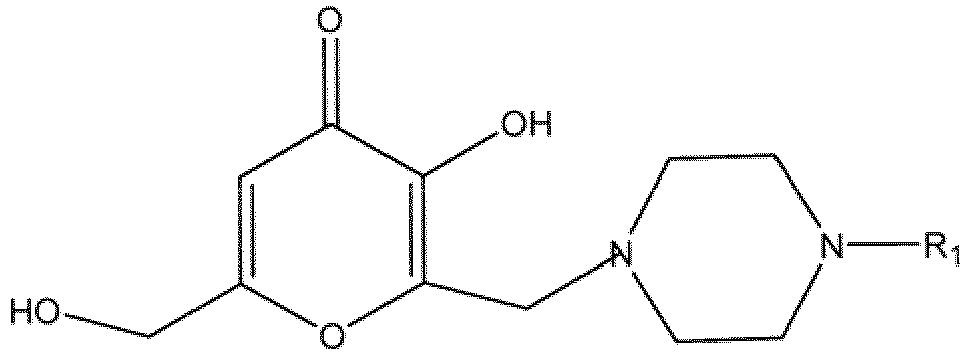
wherein R1 is

or hydrates, solvates, pharmaceutically acceptable salts or geometric isomers thereof.
wherein R1 is
or hydrates, solvates, pharmaceutically acceptable salts or geometric isomers thereof.
2. A compound according to claim 1, characterized in that the said compound is 3-Hydroxy-6-(hydroxymethyl)-2-[[4-(3,4-diclorobenzyl)piperazine-1-il]methyl]-4H-pyran-4-one.
3. A compound according to claim 1, characterized in that the said compound is 3-Hydroxy-6-(hydroxymethyl)-2-[[4-(2,6-diclorobenzyl)piperazine-1-il]methyl]-4H-pyran-4-one.
4. The compound according to claim 2 for use as antityrosinase.
5. The compound according to claim 2 for use as antimycobacterial.
6. The compound according to claim 2 for use as antidermatophytic.
7. The compound according to claim 2 for use as antioxidant.
8. The compound according to claim 2 for use as anti-aging.
9. The compound according to claim 3 for use as antimycobacterial.
10. The compound according to claim 3 for use as antidermatophytic.
11. A composition comprising a compound of the following formula

wherein R1 is

or at least one of hydrates, solvates, pharmaceutically acceptable salts or geometric isomers thereof and at least one excipient.
wherein R1 is
or at least one of hydrates, solvates, pharmaceutically acceptable salts or geometric isomers thereof and at least one excipient.
12. A composition according to claim 11, characterized in that the said composition is used as an additive in pharmaceutical, cosmeceutical and
food and textile materials.
1. Verbindung gemäß der folgenden Formel
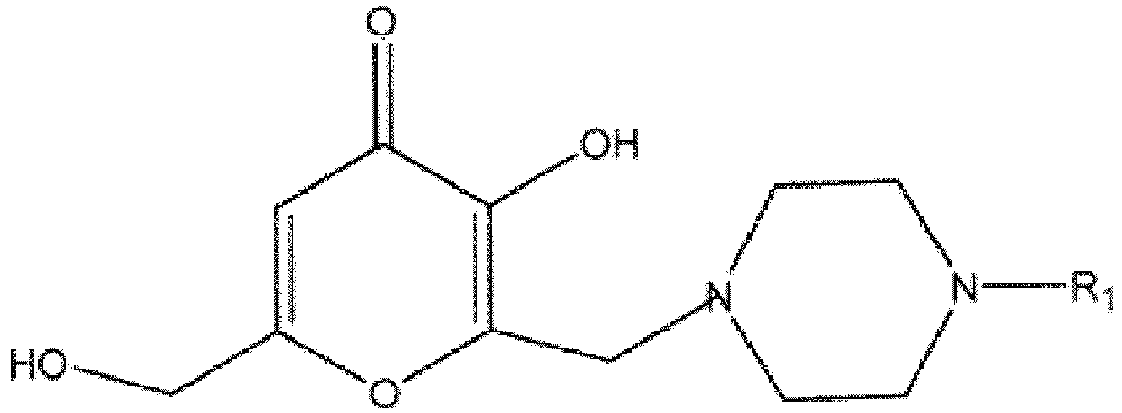
worin R1

ist
oder Hydrate, Solvate, pharmazeutisch verträgliche Salze oder geometrische Isomeren davon.
worin R1
ist
oder Hydrate, Solvate, pharmazeutisch verträgliche Salze oder geometrische Isomeren davon.
2. Verbindung nach Anspruch 1, dadurch gekennzeichnet, dass die genannte Verbindung 3-Hydoxy-6-(hydroxymethyl)-2-[[4-(3,4-dichlorobenzyl)piperazin-1-il]methyl]-4H-pyran-4-on ist.
3. Verbindung nach Anspruch 1, dadurch gekennzeichnet, dass die genannte Verbindung 3-Hydroxy-6-(hydroxymethyl)-2-[[4-(2,6-dichlorobenzyl)piperazin-1-il]methyl-4H-pyran-4-on ist.
4. Verbindung nach Anspruch 2 zur Verwendung als Antityrosinase.
5. Verbindung nach Anspruch 2 zur Verwendung als Antimykobakterium.
6. Verbindung nach Anspruch 2 zur Verwendung als Antidermatophytikum.
7. Verbindung nach Anspruch 2 zur Verwendung als Antioxidans.
8. Verbindung nach Anspruch 2 zur Verwendung als Anti-Aging-Mittel.
9. Verbindung nach Anspruch 3 zur Verwendung als Antimykobakterium.
10. Verbindung nach Anspruch 3 zur Verwendung als Antidermatophytikum.
11. Verbindung gemäß der folgenden Formel
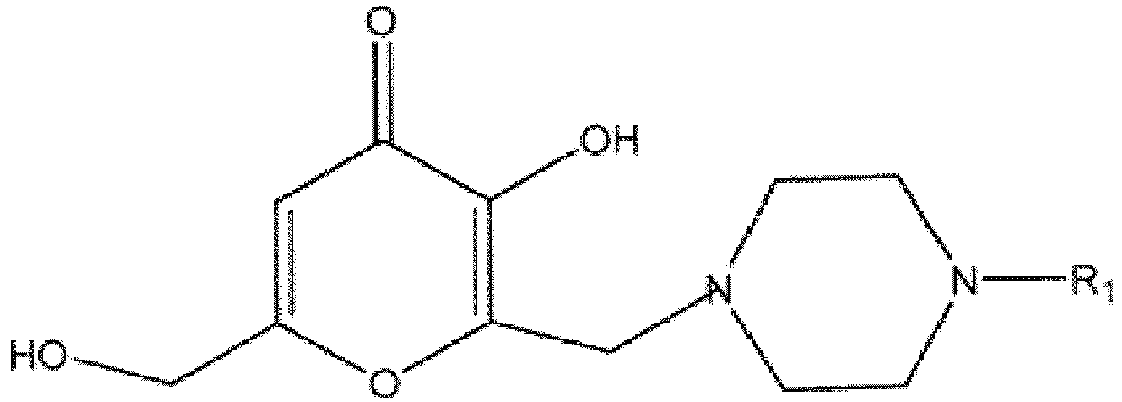
worin R1

ist
oder mindestens eines von Hydraten, Solvaten, pharmazeutisch verträglichen Salzen oder geometrischen Isomeren davon und mindestens einem Hilfsstoff.
worin R1
ist
oder mindestens eines von Hydraten, Solvaten, pharmazeutisch verträglichen Salzen oder geometrischen Isomeren davon und mindestens einem Hilfsstoff.
12. Verbindung nach Anspruch 11, charakterisiert dadurch, dass die genannte Verbindung
als ein Additiv in pharmazeutischen, kosmetischen Materialien und Lebensmittel und
Textilmaterialien verwendet wird.
1. Composé de la formule suivante
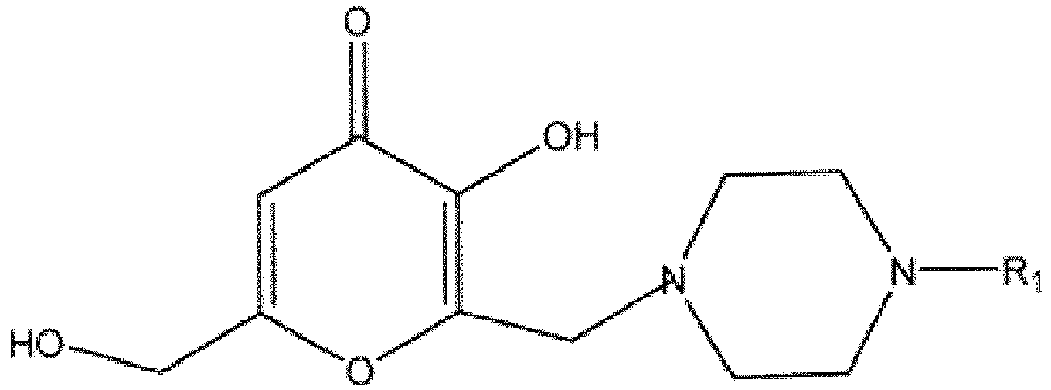
dans laquelle R1 est

ou des hydrates, des solvates, des sels pharmaceutiquement acceptables ou des isomères géométriques de celui-ci.
dans laquelle R1 est
ou des hydrates, des solvates, des sels pharmaceutiquement acceptables ou des isomères géométriques de celui-ci.
2. Composé selon la revendication 1, caractérisé en ce que ledit composé est 1a 3-hydroxy-6-(hydroxyméthyl)-2-[[4-(3,4-diclorobenzyl)pipérazine-1-il]méthyl]-4H-pyran-4-one.
3. Composé selon la revendication 1, caractérisé en ce que ledit composé est la 3-hydroxy-6-(hydroxyméthyl)-2-[[4-(2,6-diclorobenzyl)pipérazine-1-il]méthyl]-4H-pyran-4-one.
4. Composé selon la revendication 2 pour son utilisation en tant qu'antityrosinase.
5. Composé selon la revendication 2 pour son utilisation en tant qu' antimycobactérien.
6. Composé selon la revendication 2 pour son utilisation en tant qu'antidermatophytique.
7. Composé selon la revendication 2 pour son utilisation en tant qu'antioxydant.
8. Composé selon la revendication 2 pour son utilisation en tant qu'agent antivieillissement.
9. Composé selon la revendication 3 pour son utilisation en tant qu'antimycobactérien.
10. Composé selon la revendication 3 pour son utilisation en tant qu'antidermatophytique.
11. Composition comprenant un composé de la formule suivante :
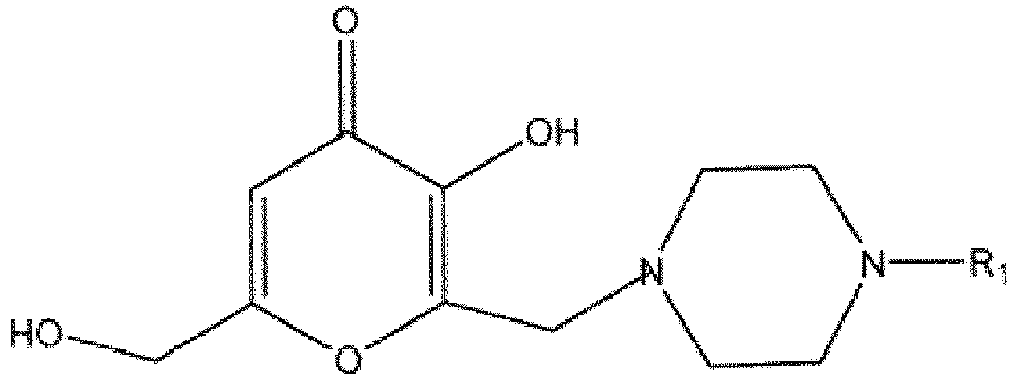
dans laquelle R1 est

ou au moins l'un d'hydrates, de solvates, de sels pharmaceutiquement acceptables ou d'isomères géométriques de celui-ci et au moins un excipient.
dans laquelle R1 est
ou au moins l'un d'hydrates, de solvates, de sels pharmaceutiquement acceptables ou d'isomères géométriques de celui-ci et au moins un excipient.
12. Composition selon la revendication 11, caractérisée en ce que ladite composition est utilisée en tant qu'additif dans des matières pharmaceutiques,
cosméceutiques et alimentaires et textiles.
